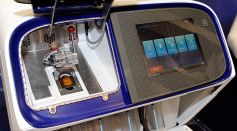NANOTECHNOLOGY

Friction-Powered Clothing Can Give Self-Sufficient Energy for Wearables

Ice Formation on Graphene Shows the Need for Heat
Gold Standard Compound Possible Alternative for Thermoelectric Devices, Helps Reduce Waste Heat
Soft Graphene Material Made Ultrastiff Through Optical Forging
Nano-Sized Robots, Vehicles Developed to Deliver Drugs Against Cancers, Blood Clots

Experts Discover Semimetal with Naturally Occurring Quantum Criticality
2D Material More Than Just Graphene; 'Nanomesh' Developed for More Efficient Quantum Communications
Graphene Nanoribbons Show Interesting Properties Due to Interplay Between Their Crystal, Electronic Structures

Superfast DNA Sequencing Tech Lands Finnish "Nobel" Victory to Two British Chemists
NanoGear: An Interlocking Mechanical System in the Molecular Scale

Fast Deterioration of Concrete and Asphalt Finally Uncovered in New Study
Crystal Defects at the Nanoscale Could Lead to Better Energy Storage Devices
Nanoparticles in Chemotherapy Drugs Could Soon Help Destroy Bowel Cancer
New Magnetic Material Breaks Previous Records on Switching Speeds
Most Popular

Will Earth's Magnetic Poles Flip Next? Magnetic Pole Reversal Explained Through Cutting‑Edge Magnetosphere Science

Relativity Time Dilation Explained: The Physics of Time and Why It Moves Differently in Space

How Lightning Science Reveals Why Charged Storms Are Rising with Global Warming Effects

How AI Is Used in Weather Prediction: Smarter Forecasting Through Machine Learning





